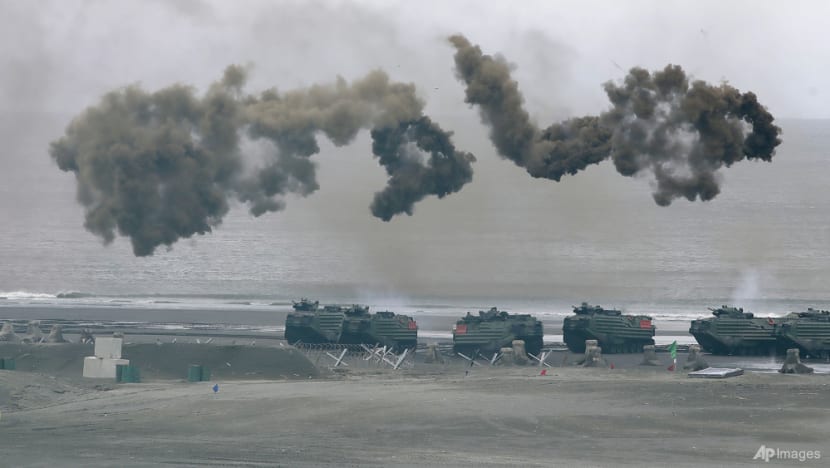Taiwan holds annual live-fire drills at Taoyuan International Airport for the first time
Taiwan has been ramping up its preparation for a possible attack from Beijing, especially after China launched its largest military exercise around the island following then US House Speaker Nancy Pelosi’s visit to Taiwan last August.

Taiwan's military holds drills of the annual Han Kuang military exercises that simulate an anti-landing operations near the coast in New Taipei City, northern Taiwan, Thursday, July 27, 2023. Taiwan military mobilized for routine defense exercises from July 24-28. (AP Photo/Chiang Ying-ying)
TAOYUAN: Paratroopers posing as Chinese People’s Liberation Army (PLA) descend from a Black Hawk helicopter and Taiwan’s ground troops are immediately deployed to repel the airborne assault, securing the runways at Taoyuan international airport.
This scenario was among the week-long exercise simulating attacks from China at this year's Han Kuang military drill. The annual event that showcases Taiwan’s defence capabilities primarily designed to counter possible military attacks from China.
The fast-approaching super typhoon Doksuri disrupted the first two days of the live-fire drills, but the exercise that was held at the airport for the first time received the go-ahead.
Taiwan has been ramping up its preparation for a possible attack from Beijing especially, after China launched its largest military exercise around the island following then US House Speaker Nancy Pelosi’s visit to Taiwan last August.
Her visit took place at the height of the Ukraine war, which led to heightened speculation from the west that Taiwan could face a similar onslaught from China.
Taiwan's defence ministry is keen to draw experiences from the Ukraine war by converting civilian facilities for military purposes, starting with its commercial airport.
NECESSITY OF DRILLS
Military experts said the drill was necessary because Taoyuan Airport is just 3km from Zhuwei beach, a potential landing point for the PLA.
“If the international airport was seized, the enemy would move into the second phase of assault or replenish supply to further expand its attack (so it's important to conduct this defence drill)," said senior analyst at the Institute for National Defense and Security Research Su Tzu Yun.
"This airport drill would help Taiwan’s air force to use the runways as backup for military aircraft to take off and land."
Taiwan has increased its military spending by 14 per cent this year to US$18.8 billion amid escalating tensions across the strait. But China’s military budget is more than 10 times higher than the island’s.
Analysts said asymmetric warfare - a form of irregular warfare where combatants are not from regular military forces - could be the key in making up for Taiwan’s gaps.
“Taiwan must have the capability of asymmetric warfare in order to prolong the (potential) war and protect our land, allowing other countries to supply aid to the island,” said Mr Arthur Wang, spokesman for the Asia-Pacific Elite Interchange Association.
Mr Su said that the Taiwan strait will geographically help with the island’s defence.
“With modern missile technology, it will give Taiwan the chance to build up its advantage both on air and at sea to stop the attack from the enemy,” he added.
Despite such capabilities, analysts said the best way to resolve cross-strait issues is through peaceful dialogue.

















